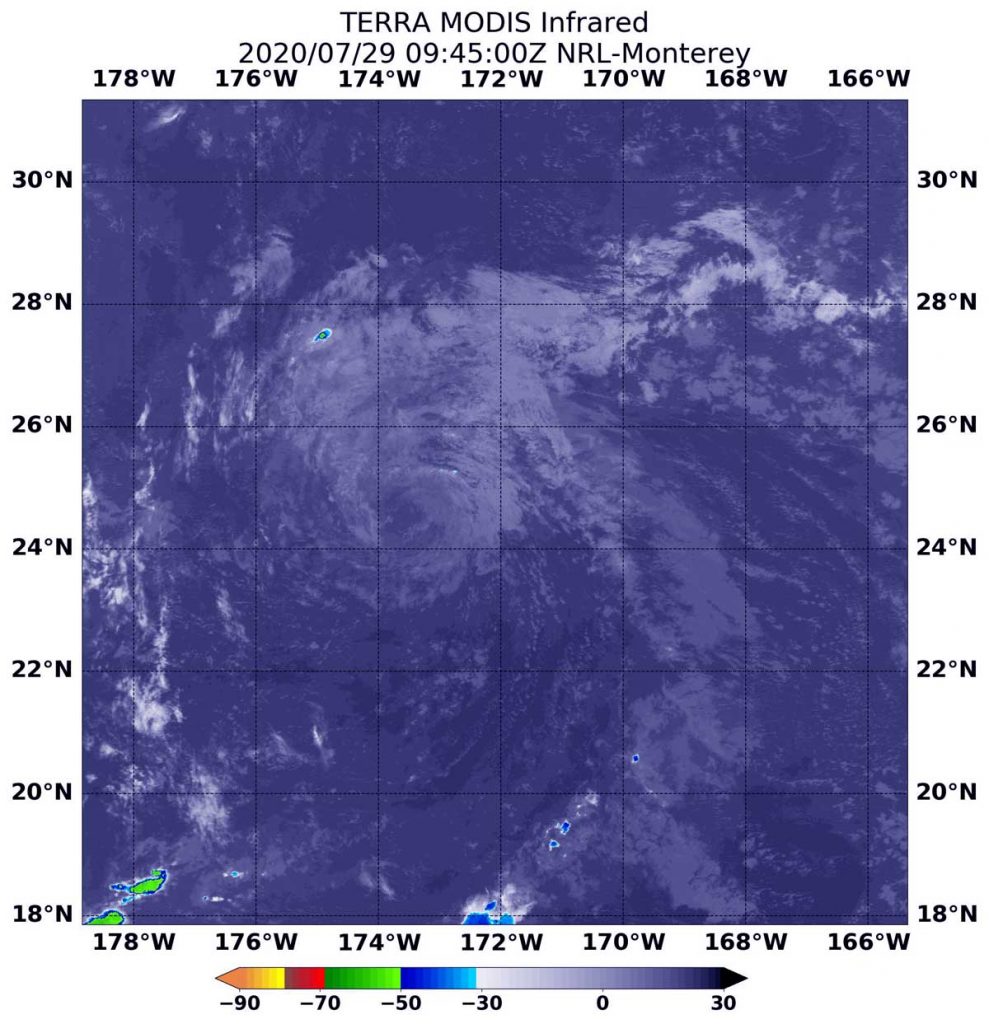July 29, 2020 – NASA’s Terra Satellite Finds No Strong Storms Left in Tropical Storm Douglas
Strong wind shear has been the undoing of Tropical Storm Douglas. NASA’s Terra satellite provided infrared data revealed the tropical cyclone was devoid of strong storms, indicating wind shear has weakened it.

One Warning Remains for Douglas
On July 29, a Tropical Storm Warning is in effect for portions of the Papahanaumokuakea Marine National Monument from Maro Reef to Lisianski.
NASA’s Terra Satellite Reveals Effects of Wind Shear
NASA’s Terra satellite uses infrared light to analyze the strength of storms by providing temperature information about the system’s clouds. The strongest thunderstorms that reach high into the atmosphere have the coldest cloud top temperatures. However, cloud tops in Douglas showed no very cold cloud tops on July 29 at 5:45 a.m. EDT (0945 UTC) when they were imaged by the Moderate Resolution Imaging Spectroradiometer or MODIS instrument that flies aboard NASA’s Terra satellite.
Wind shear had sapped the strength of the storm and prevented strong thunderstorms from forming. Tropical cyclones are made up of hundreds of thunderstorms, and when there are no strong storms present in satellite imagery, it is a sure sign of weakening.
At 5 a.m. EDT (0900 UTC) on July 29/11 p.m. HST on July 28, NOAA’s Central Pacific Hurricane Center (CPHC) in Honolulu, Hawaii noted, “Due to persistent southerly vertical wind shear, Douglas has been devoid of deep convection for nearly 24 hours, and it appears that it will soon be a post-tropical remnant low.”
About Wind Shear
The shape of a tropical cyclone provides forecasters with an idea of its organization and strength. Wind shear occurs when outside winds batter a storm and change the storm’s shape pusing much of the associated clouds and rain to one side of it.
In general, wind shear is a measure of how the speed and direction of winds change with altitude. Tropical cyclones are like rotating cylinders of winds. Each level needs to be stacked on top each other vertically in order for the storm to maintain strength or intensify. Wind shear occurs when winds at different levels of the atmosphere push against the rotating cylinder of winds, weakening the rotation by pushing it apart at different levels. Southwesterly wind shear was pushing the bulk of Douglas’ clouds to the north-northeast of the center.
Status of Tropical Storm Douglas on July 29, 2020
At 8 a.m. EDT (2 a.m. HST/1200 UTC), the center of Tropical Storm Douglas was located near latitude 24.7 degrees north and longitude 174.3 degrees west. Douglas is about 320 miles (515 km) southeast of Midway Island. Douglas was moving toward the west near 23 mph (37 km/h), and this general motion is expected to continue until Douglas crosses the International Date Line in about 24 hours. Maximum sustained winds were near 40 mph (65 kph) with higher gusts. The estimated minimum central pressure is 1010 millibars.
Forecast for Douglas
NOAA’s CPHC said, “Large seas and swells generated by Douglas will impact portions of the Papahanaumokuakea Marine National Monument west of Maro Reef through Wednesday. These swells may produce large breaking waves that could inundate some of the lower-lying atolls. Rainfall associated with Douglas will impact portions of the Papahanaumokuakea Marine National Monument west of Maro Reef through Wednesday.”
Weakening is forecast during the next two days, and Douglas is expected to dissipate shortly after crossing the Date Line.
NASA Researches Tropical Cyclones
Hurricanes/tropical cyclones are the most powerful weather events on Earth. NASA’s expertise in space and scientific exploration contributes to essential services provided to the American people by other federal agencies, such as hurricane weather forecasting.
For more than five decades, NASA has used the vantage point of space to understand and explore our home planet, improve lives and safeguard our future. NASA brings together technology, science, and unique global Earth observations to provide societal benefits and strengthen our nation. Advancing knowledge of our home planet contributes directly to America’s leadership in space and scientific exploration.
For updated forecasts. visit: www.nhc.noaa.gov
